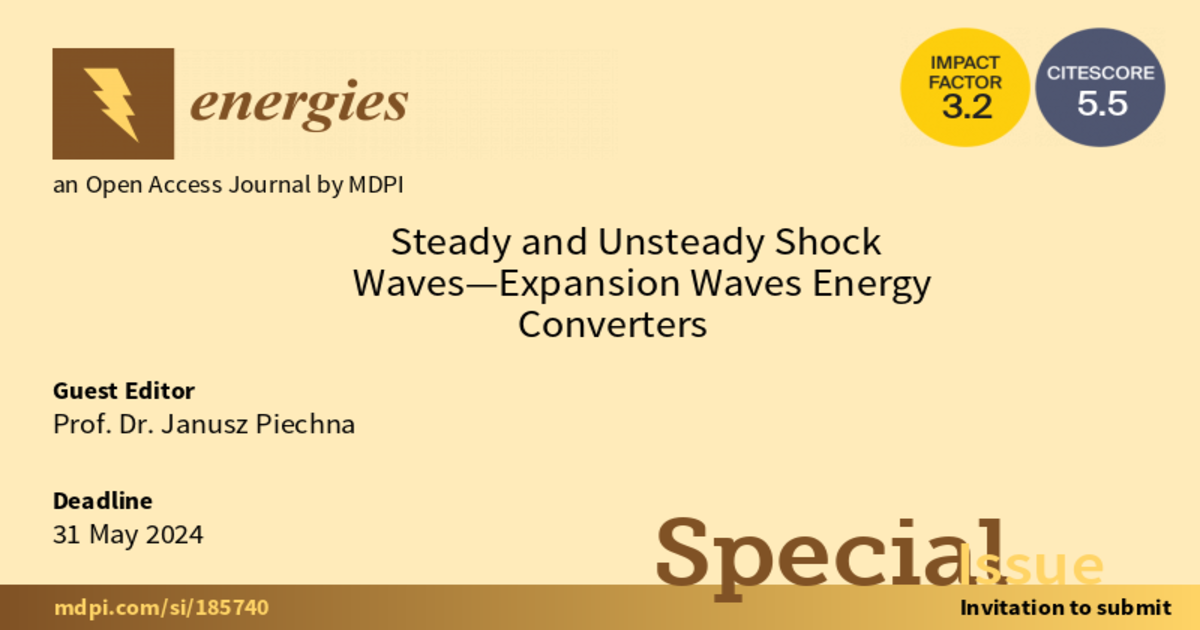Steady and Unsteady Shock Waves—Expansion Waves Energy Converters
A special issue of Energies (ISSN 1996-1073). This special issue belongs to the section "F3: Power Electronics".
Deadline for manuscript submissions: 31 May 2024 | Viewed by 1118

Special Issue Editor
Interests: fluid mechanics; gas dynamics; numerical simulations; fluid mechanics; unsteady flows; car aerodynamics; aerodynamics of animals; CFD; computational fluid dynamics
Special Issues, Collections and Topics in MDPI journals
Special Issue Information
Dear Colleagues,
The compression and expansion processes of compressible media are the basis of operation of many devices such as heat engines, refrigerators, heat pumps, compressor–expanders in chemical plants, and chemical reactors. Classical compression systems based on multi-stage axial compressors are extremely complex, expensive, and of considerable size. Compressors based on the use of stationary or moving shock waves are simple in design, have small dimensions, and are not as expensive.
Attempts at their practical use have been ongoing for years. Solutions based on transient processes have been realised in devices such as the Comprex and Hyprex compressors, directly in prototypes of heat engines, and gas compression and expansion components in refrigeration and chemical plants. Shock waves generated on rotating compressor and engine components have been used in experimental heat engines and with great success in chemical plants. Comprex-type wave compressors may make a comeback in electric cars with range extenders using environmentally clean synthetic fuels, increasing the efficiency and power of specialised engines used only periodically to charge the car's battery.
An equally interesting area of use for moving shock waves are applications of moving detonation waves that occur when shock waves move through a zone containing a combustible mixture. Applications of pulsating or rotating detonation waves are found in rocket engines or flow engine combustion chambers.
Developments in 3D printing technology may contribute to the wider use of abnormal compression using both stationary and moving shock waves.
This Special Issue aims to bring together and provide a broad presentation of the latest developments in this very extensive but quite specialized area of knowledge.
Prof. Dr. Janusz Piechna
Guest Editor
Manuscript Submission Information
Manuscripts should be submitted online at www.mdpi.com by registering and logging in to this website. Once you are registered, click here to go to the submission form. Manuscripts can be submitted until the deadline. All submissions that pass pre-check are peer-reviewed. Accepted papers will be published continuously in the journal (as soon as accepted) and will be listed together on the special issue website. Research articles, review articles as well as short communications are invited. For planned papers, a title and short abstract (about 100 words) can be sent to the Editorial Office for announcement on this website.
Submitted manuscripts should not have been published previously, nor be under consideration for publication elsewhere (except conference proceedings papers). All manuscripts are thoroughly refereed through a single-blind peer-review process. A guide for authors and other relevant information for submission of manuscripts is available on the Instructions for Authors page. Energies is an international peer-reviewed open access semimonthly journal published by MDPI.
Please visit the Instructions for Authors page before submitting a manuscript. The Article Processing Charge (APC) for publication in this open access journal is 2600 CHF (Swiss Francs). Submitted papers should be well formatted and use good English. Authors may use MDPI's English editing service prior to publication or during author revisions.
Keywords
- SWCRE—shock wave compression rotary engine
- RDE—rotating detonation engines
- Ramjet—supersonic flow engines with air shock wave compression
- PWR—pressure wave refrigerator
- RWE—radial wave engine
- WHP—wave heat pump
- PWE—pressure wave exchangers
- WR—wave rotors
- GWR—gas wave refrigerator (GWR)
- RDC—rotating detonation chamber
- OWDE—hypersonic oblique wave detonation engine
- SWE—shock wave engine
- PC—pulse combustors
- DWC—detonation-wave combustors
- SWR—shock wave reformer
- SWH—shock wave heater





